
Proclaiming the Gospel of Joy: Living Christ’s Mission
Pastoral Letter and Plan
(Download this entire document as a PDF here | En español)
We, the Roman Catholic Archdiocese of Indianapolis, joyfully proclaim the Gospel of Jesus Christ to all people by living his mission of mercy, hope and salvation.
Dear Brothers and Sisters in Christ:
 In his 2013 Apostolic Exhortation Evangelii gaudium (“The Joy of the Gospel”), Pope Francis invited the entire Church “to embark on a new chapter of evangelism.” He also challenged us to understand ourselves as a “community of missionary disciples” who are “permanently in a state of mission” (EG #s 1–3). This state of mission defines our Church’s ministry in both good times and hard times. As our Holy Father observes:
In his 2013 Apostolic Exhortation Evangelii gaudium (“The Joy of the Gospel”), Pope Francis invited the entire Church “to embark on a new chapter of evangelism.” He also challenged us to understand ourselves as a “community of missionary disciples” who are “permanently in a state of mission” (EG #s 1–3). This state of mission defines our Church’s ministry in both good times and hard times. As our Holy Father observes:
Though it is true that this mission demands great generosity on our part, it would be wrong to see it as a heroic individual undertaking, for it is first and foremost the Lord’s work, surpassing anything which we can see and understand. Jesus is “the first and greatest evangelizer.” In every activity of evangelization, the primacy always belongs to God, who has called us to cooperate with him and who leads us on by by the power of his Spirit. The real newness is the newness which God himself mysteriously brings about and inspires, provokes, guides and accompanies in a thousand ways. The life of the Church should always reveal clearly that God takes the initiative, that “he has loved us first” (1 Jn 4:19) and that he alone “gives the growth” (1 Cor 3:7). This conviction enables us to maintain a spirit of joy in the midst of a task so demanding and challenging that it engages our entire life. God asks everything of us, yet at the same time he offers everything to us (EG #12).
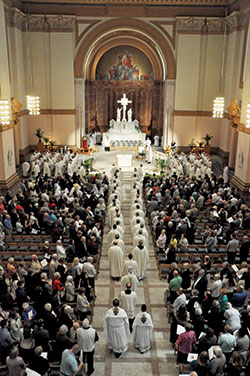 Even in challenging times such as these, God takes the initiative, and he gives us everything we need to carry out his work. Our responsibility as disciples and missionaries is to gather around the Lord to pray, to listen to God’s Word and to encounter him in the sacraments and the liturgy. Then, we must accept his commission to “go out to the whole world” in our proclamation of the Gospel and in service to others.
Even in challenging times such as these, God takes the initiative, and he gives us everything we need to carry out his work. Our responsibility as disciples and missionaries is to gather around the Lord to pray, to listen to God’s Word and to encounter him in the sacraments and the liturgy. Then, we must accept his commission to “go out to the whole world” in our proclamation of the Gospel and in service to others.
This state of mission, that is the essential nature of the Church, has taken different forms at various times and among diverse communities in the Church’s 2,000-year history. What the Church looked like in its earliest days during the Roman Empire was far different from the forms it took in the Middles Ages, the Renaissance, the Counter-Reformation and the succeeding periods of Church history. As she remains the one, holy, catholic and apostolic Church that we profess in the Nicene Creed, our Church today must be attentive to “the signs of the times” and adapt her organization and ministries to the needs of people today—while always remaining faithful to her core teaching and practices.
This is why popes convene councils and synods to assess issues that confront the People of God. It’s also why bishops and pastors periodically engage in pastoral planning to help identify needs and respond appropriately to the demands of our permanent state of mission in a rapidly changing world.
“Christ the Cornerstone” is my episcopal motto. St. Peter uses this expression, “the stone that the builders rejected has become the cornerstone,” in his first letter to the Gentile converts in Asia Minor (cf. 1 Pt 2:7). He is quoting Psalm 118, verse 22. “The stone which the builders rejected has become the cornerstone.” St. Peter and other New Testament writers interpreted this verse as referring to the death and resurrection of Jesus Christ, the one who was rejected by the political and religious leaders of his time but is now the foundation on which our lives are built. All our planning initiatives in the Church must have the person of Jesus Christ as their foundation or cornerstone.
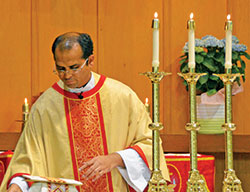 More than 20 years ago, Pope St. John Paul II outlined the task that the Church faced as we prepared to enter into a new millennium:
More than 20 years ago, Pope St. John Paul II outlined the task that the Church faced as we prepared to enter into a new millennium:
We are certainly not seduced by the naive expectation that, faced with the great challenges of our time, we shall find some magic formula. No, we shall not be saved by a formula but by a Person, and the assurance which he gives us: I am with you!
It is not therefore a matter of inventing a “new program”. The program already exists: it is the plan found in the Gospel and in the living Tradition, it is the same as ever. Ultimately, it has its center in Christ himself, who is to be known, loved and imitated, so that in him we may live the life of the Trinity, and with him transform history until its fulfillment in the heavenly Jerusalem. This is a program which does not change with shifts of times and cultures, even though it takes account of time and culture for the sake of true dialogue and effective communication. This program for all times is our program for the Third Millennium. But it must be translated into pastoral initiatives adapted to the circumstances of each community.
What awaits us therefore is an exciting work of pastoral revitalization—a work involving all of us (Pope St. John Paul II, Novo Millennio Ineunte #29).
 Pope Francis echoes this teaching when he speaks about the importance of “pastoral conversion” which is much more than restructuring our parishes, schools and diocesan institutions. The “exciting work of pastoral revitalization” that St. John Paul says awaits us all is what Pope Francis means when he talks about “pastoral ministry in a missionary key.”
Pope Francis echoes this teaching when he speaks about the importance of “pastoral conversion” which is much more than restructuring our parishes, schools and diocesan institutions. The “exciting work of pastoral revitalization” that St. John Paul says awaits us all is what Pope Francis means when he talks about “pastoral ministry in a missionary key.”
According to Pope Francis, pastoral planning challenges us to abandon the complacent attitude that says: “We have always done it this way.” It invites us to be bold and creative in this task of rethinking the goals, structures, style and methods of evangelization in our respective communities. Planning that seeks to translate the permanent mission of the Church into pastoral initiatives that can effectively address the challenges and opportunities of our contemporary situation must reflect deeply on the Gospel and the essential teachings and practices of the Church. As Pope Francis makes clear: “A proposal of goals without an adequate communal search for the means of achieving them will inevitably prove illusory.” The Holy Father goes on to say that “the important thing is to not walk alone, but to rely on each other as brothers and sisters, and especially under the leadership of the bishops, in a wise and realistic pastoral discernment” (EG #33).
As Archbishop of Indianapolis, it is my responsibility to lead this archdiocese in assessing the needs of the Church in central and southern Indiana and planning for the future. This is not something I can, or should, do all by myself. Successful planning requires broad consultation and teamwork. It requires a profound sense of openness to the guidance of the Holy Spirit—as this is manifested both through the rich history of the Church in this region and in the present circumstances. Ultimately, sound pastoral planning demands that we be willing to trust that although we cannot predict the future, Divine Providence will show us the way to carry out God’s will for us in the years ahead.
A Future Full of Hope
 On 19 February 2020, before the spread of the COVID-19 pandemic compelled us to suspend temporarily all public gatherings including Mass and the sacraments, I accepted as proposed by the planning committee a new archdiocesan pastoral plan that will guide the way we carry out the Church’s mission in central and southern Indiana for the next three years. This plan is the result of several years of surveys, assessments and research beginning during the interim between the appointment of Cardinal Joseph W. Tobin as archbishop of Newark, N.J., and my installation as archbishop of Indianapolis on 28 July 2017.
On 19 February 2020, before the spread of the COVID-19 pandemic compelled us to suspend temporarily all public gatherings including Mass and the sacraments, I accepted as proposed by the planning committee a new archdiocesan pastoral plan that will guide the way we carry out the Church’s mission in central and southern Indiana for the next three years. This plan is the result of several years of surveys, assessments and research beginning during the interim between the appointment of Cardinal Joseph W. Tobin as archbishop of Newark, N.J., and my installation as archbishop of Indianapolis on 28 July 2017.
At the conclusion of my first year of episcopal ministry here, I commissioned a planning team of 25 members from around the archdiocese who represent different walks of life—lay people, priests, religious, people who work in archdiocesan and parish ministries, as well as people of different ethnicities and of various ages. The planning team’s first task was to read The Joy of the Gospel by Pope Francis and to reflect on its teaching in light of the opportunities and challenges we face as we seek to proclaim the Gospel in our current situation. We wanted our future plans to be rooted in the Holy Father’s vision for the Church of yesterday, today and tomorrow as this is expressed in sacred Scripture: “For I know well the plans I have in mind for you—says the Lord—plans for your welfare and not for woe, so as to give you a future of hope” (Jer 29:11).
I am deeply grateful for the pastoral plan’s coordinating committee: Annette “Mickey” Lentz, chancellor; Msgr. William F. Stumpf, vicar general; David Bethuram, executive director of Catholic Charities; and Greg Otolski, executive director of communications. They worked tirelessly to oversee the plan’s development and to ensure that the plan itself reflects the themes identified in The Joy of the Gospel, our guiding document.
 I also want to acknowledge gratefully the other 21 members of the Archdiocesan Pastoral Planning Committee:
I also want to acknowledge gratefully the other 21 members of the Archdiocesan Pastoral Planning Committee:
Julie Alberston
Loraine Brown
J. Patrick Byrne
Oscar Castellanos
Christine Eppert
Matt Faley
Father Rick Ginther
Steven Goebel
Kara Gresh
Amy Higgins
Deacon Stephen Hodges
Erin Jeffries
Deacon Marc Kellams
Sister Joanita Koors, OSF
Father Doug Marcotte
Bernie Paradise
Leticia Pasillas
Richard Pohlman
Pearlette Springer
Sue Weber (facilitator)
Lynne Weisenbach
Their prayerful dedication to the task they were given was an inspiration and a significant source of hope for the future of our archdiocese. No matter what obstacles we may face, we are a faith-filled community determined to hear the Word of God, discern the Lord’s Will for us, and act with wisdom, courage and confidence in the Holy Spirit. My thanks to these pastoral leaders and to all who participated in the surveys and assessments that prepared the way for this pastoral planning process.
Mission and Goals
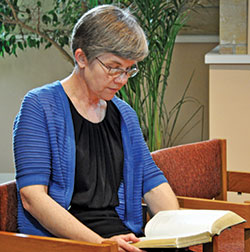 Especially as we return to full engagement in the mission and ministries of our archdiocese, there are many advantages to having a pastoral plan that can serve as a practical guide for all our ministries. Our pastoral plan provides a means for shared vision and coordinated, intentional efforts. The plan also identifies particular goals and objectives that need to be addressed in this moment of our archdiocese’s history. Finally, the plan makes it possible for us to work together as a family of faith rather than trying to address each issue as isolated individuals.
Especially as we return to full engagement in the mission and ministries of our archdiocese, there are many advantages to having a pastoral plan that can serve as a practical guide for all our ministries. Our pastoral plan provides a means for shared vision and coordinated, intentional efforts. The plan also identifies particular goals and objectives that need to be addressed in this moment of our archdiocese’s history. Finally, the plan makes it possible for us to work together as a family of faith rather than trying to address each issue as isolated individuals.
The Archdiocesan Pastoral Planning Committee has proposed, and I have approved, the following Mission Statement for our archdiocese:
We, the Roman Catholic Archdiocese of Indianapolis, joyfully proclaim the Gospel of Jesus Christ to all people by living his mission of mercy, hope and salvation.
As Pope Francis reminds us in The Joy of the Gospel, the call to faith and salvation in Jesus Christ, which is at the heart of our Mission Statement, is God’s work. By his grace, we, the Church in central and southern Indiana, are sent out into the world to proclaim the Gospel joyfully by our living witness to his mission of mercy, hope and salvation.
In The Joy of the Gospel, our Holy Father writes:
The salvation which God offers us is the work of his mercy. No human efforts, however good they may be, can enable us to merit so great a gift. God, by his sheer grace, draws us to himself and makes us one with him. He sends his Spirit into our hearts to make us his children, transforming us and enabling us to respond to his love by our lives. The Church is sent by Jesus Christ as the sacrament of the salvation offered by God. Through her evangelizing activity, she cooperates as an instrument of that divine grace which works unceasingly and inscrutably (EG #112).
We carry out our mission as the Church in central and southern Indiana by our cooperation with the grace of Jesus Christ, and, in the process, we commit ourselves to accomplishing the five overarching goals listed below. By committing our archdiocese to this “permanent state of mission,” we strive to “live the life of the Trinity” and by the grace of God to transform the history of this time and place “until its fulfillment in the heavenly Jerusalem.”
Goals and Objectives
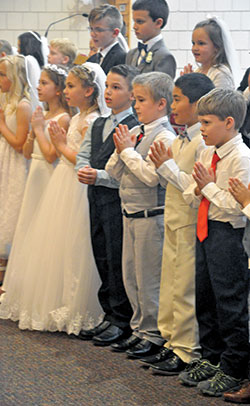 The Archdiocesan Pastoral Planning Committee was responsible for prayerfully considering the results of the assessments, surveys and other research conducted in preparation for pastoral planning. This was truly a process of prayerful discernment using Sacred Scripture, the teaching and practice of the Church during the past two millennia, and Pope Francis’s recent teaching, especially The Joy of the Gospel, as guides. The result was a series of Goals and Objectives in the following areas:
The Archdiocesan Pastoral Planning Committee was responsible for prayerfully considering the results of the assessments, surveys and other research conducted in preparation for pastoral planning. This was truly a process of prayerful discernment using Sacred Scripture, the teaching and practice of the Church during the past two millennia, and Pope Francis’s recent teaching, especially The Joy of the Gospel, as guides. The result was a series of Goals and Objectives in the following areas:
- Prayer and Worship
- Stewardship
- Family and Community
- Evangelization and Catechesis
- Clergy Life and Ministry
These five areas do not encompass all aspects of the Church’s life and ministry here in central and southern Indiana, but they do provide us with a broad framework for pastoral planning that can address the key issues and concerns that we are confronting as we continue to carry out our mission.
Each of the five areas identified above includes an overarching goal (what we want to do) and a series of specific objectives (how we plan to accomplish each goal). These goals and objectives, which have been approved, have now been given to the appropriate archdiocesan offices and agencies that will develop detailed plans for implementation, including accountability (measures for success, persons responsible, timelines, and budget implications).
For the purposes of this pastoral letter, I would simply like to offer some brief reflections on the five goals and their importance for carrying out our mission—yesterday, today and tomorrow.
Goal I: Prayer and Worship
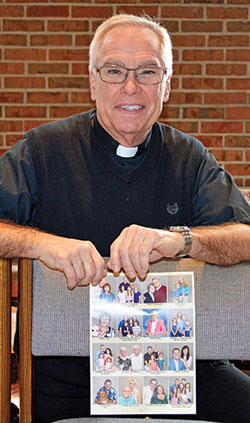 The first goal of our Archdiocesan Pastoral Plan is: Foster a personal encounter with Jesus Christ through a rich and vibrant liturgical, sacramental and devotional, and personal prayer life. Prayer and Worship are at the heart of our identity as Catholic Christians. They prepare us to encounter Jesus in Word, Sacrament and Service, and they nourish and sustain us as we carry out our mission to joyfully proclaim the Gospel and live Christ’s mission of mercy, hope and salvation. The encounter with Jesus Christ that our liturgy and the sacraments foster is never a purely private affair. Mass and the sacraments, especially, are meant to be communal celebrations which both unite us in worship and strengthen us as individuals and communities in love of God and love of neighbor.
The first goal of our Archdiocesan Pastoral Plan is: Foster a personal encounter with Jesus Christ through a rich and vibrant liturgical, sacramental and devotional, and personal prayer life. Prayer and Worship are at the heart of our identity as Catholic Christians. They prepare us to encounter Jesus in Word, Sacrament and Service, and they nourish and sustain us as we carry out our mission to joyfully proclaim the Gospel and live Christ’s mission of mercy, hope and salvation. The encounter with Jesus Christ that our liturgy and the sacraments foster is never a purely private affair. Mass and the sacraments, especially, are meant to be communal celebrations which both unite us in worship and strengthen us as individuals and communities in love of God and love of neighbor.
Goal I objectives specify cultivating a sense of belonging through liturgical experiences that honor our archdiocese’s growing cultural and ethnic diversity; offering resources to parishes to encourage full, active, and conscious participation in the liturgical life of the Church; enriching and complementing our understanding of the Gospel, Scripture and Liturgy through music and song that honors and celebrates our cultural and ethnic diversity; fostering the spiritual life of God’s people through “popular piety” devotions; and promoting sacramental preparation as a tool of new evangelization, and as an encounter for candidates, families and sponsors with the risen Lord.
Pope Francis continually reminds us that the Church’s ministry must always be grounded in prayer and worship. “It is important for us to regain our confidence that by the power of God and our cooperation with Him, we can face and meet any challenges.” The Holy Father also tells us all—beginning with those of us who are bishops—that “prayer is not a devotion but a necessity; it is not one task among many, but an indispensable ministry of intercession” (Pope Francis, Audience with participants in a seminar organized by the Congregation for the Evangelization of Peoples, 8 September 2018).
Goal 2: Stewardship
Our second goal is: To cultivate a culture of stewardship responding to our baptismal call through the giving of one’s time, talent and treasure in the service of God and others. We understand stewardship to be the awareness that all we have and are come to us from God as gifts to be developed responsibly and then shared generously with others. Stewardship is essential to our mission because it is a way of living Gospel values in the concreteness of daily life. There is no opposition between “authority” and “mission” when we accept the fundamental truth that we are stewards, not owners, sent by God to share His gifts in the building up of His Kingdom.
Goal 2 objectives include: Fostering an increased sense of discipleship among the people by helping them identify the gifts that God has given them and how those gifts can be put into service to build up His kingdom through the Church; designing and implementing an archdiocesan-wide system that connects/coordinates the faithful’s gifts/talents with the needs of the archdiocese, wider-community, and the parish and invites and actively engages the faithful into service of others; conducting a comprehensive assessment or audit of all capital assets and facilities within the archdiocese regarding short/long-term maintenance and usability (building on previous audits/assessments) and developing standardized methods and reports to assess resources and pastoral needs throughout the archdiocese; and continuing to use the tools and resources gained from the archdiocese’s Empowering Pastoral Leaders project as a means to build up the leadership capacity, skills and talents of all.
In his inaugural Mass on
19 March 2013, Pope Francis said, “In the end, everything
has been entrusted to our protection, and all of us are responsible for it. Be protectors of God’s gifts!” This is the call to responsible stewardship, to care for and generously share all God’s gifts. We protect God’s gifts when we acknowledge that God is their owner and we are called to be his trustworthy stewards.
Goal 3: Family and Community
 Our third goal is: Support and engage families and communities in the archdiocese. Assessments, surveys and research conducted in preparation for pastoral planning show clearly that the family, which is the most fundamental unit of civil society, and which we recognize as “the domestic church,” needs encouragement, support and direction in its efforts to flourish and grow in our contemporary culture. Recent popes have emphasized that the family is the primary place where catechesis, evangelization and social awareness are nurtured, developed and put into action to carry out our Church’s mission in the world.
Our third goal is: Support and engage families and communities in the archdiocese. Assessments, surveys and research conducted in preparation for pastoral planning show clearly that the family, which is the most fundamental unit of civil society, and which we recognize as “the domestic church,” needs encouragement, support and direction in its efforts to flourish and grow in our contemporary culture. Recent popes have emphasized that the family is the primary place where catechesis, evangelization and social awareness are nurtured, developed and put into action to carry out our Church’s mission in the world.
Goal 3 directs us to: Recognize the family as the core of our evangelization and pastoral ministry; offer resources and experiences to Catholic households in fostering and discerning vocations; cultivate communities that are centered on invitation and evangelization for people in all phases of life; affirm and promote the role of parents as the primary teachers and formators of their children’s faith; and design outreach programs and resources to actively invite and welcome inactive Catholics, to extend hospitality to first-time visitors, and to warmly receive those seeking a church home.
In the Introduction to his apostolic exhortation Amoris Laetitia (On Love in the Family), Pope Francis says, “It is my hope that, in reading this text, all will feel called to love and cherish family life, for families are not a problem; they are first and foremost an opportunity.” Our pastoral plan’s emphasis on the preeminence of family and community reflects this perspective of Christian optimism. We believe with all the assurances of our faith that families and communities today have the power (born of God’s grace) to serve as seeds of hope, centers of formation and places where the theological and cardinal virtues can be lived concretely in our daily lives.
Goal 4: Evangelization and Catechesis
Our fourth goal is: Live with an attitude of missionary discipleship of all people, reaching out to the peripheries of our diocese, parishes and communities. In The Joy of the Gospel, and throughout his preaching and teaching, Pope Francis reminds us that we are called to be missionary disciples, men and women who leave behind what is familiar and comfortable in order to proclaim the Gospel and live Christ’s mission of mercy, hope and salvation as a witness to all people, especially those on the margins of society. This is the mission we have embraced as the Church in central and southern Indiana, and we commit ourselves to reaching out to others wherever they can be found.
Goal 4 objectives include: Fostering a sense of belonging through an attitude of encounter; restoring the meaning of joy by proclaiming and evangelizing the Good News; creating a culture of intentional discipleship; making youths’ and young adults’ participation in all levels of pastoral ministry a priority; and promoting effective instruments of evangelization through solid catechesis.
In the opening paragraph of The Joy of the Gospel, Pope Francis outlines the plan of the Gospels, what St. John Paul II called, “a program which does not change with shifts of times and cultures, even though it takes account of time and culture for the sake of true dialogue and effective communication.” According to Pope Francis:
The Joy of the Gospel fills the lives and hearts of all who encounter Jesus. Those who accept his offer of salvation are set free from sin, sorrow, inner emptiness and loneliness. With Christ, joy is constantly born anew (EG #1).
This is the precise meaning of our fourth goal: To facilitate the same attitude that missionary disciples of our Lord Jesus Christ have had since the first Pentecost. We know that this “program” never changes, but we also know that it is our responsibility as pastoral leaders to present this program to the people of today and tomorrow in a spirit of true dialogue and effective communication.
Goal 5: Clergy Life and Ministry
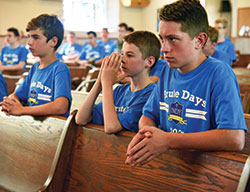 Our final goal is: Ensure the spiritual and physical well-being of the clergy by spiritual vitality, organizational efficiency, and sound stewardship principles and practices. All of the goals in our pastoral plan are vitally important, but this goal is especially significant today as we emerge from decades of crisis and humiliation resulting from the heinous crimes and grave sins of some bishops, priests and church leaders. As a Church, we love our clergy and we want them to succeed in the vocation given them by Christ to serve as pastors and ministers of all God’s people. We know that the prayerful help and support of the entire archdiocesan family is needed to nurture, affirm and guide our deacons, priests and bishops as we strive to grow spiritually and mature as effective pastoral ministers.
Our final goal is: Ensure the spiritual and physical well-being of the clergy by spiritual vitality, organizational efficiency, and sound stewardship principles and practices. All of the goals in our pastoral plan are vitally important, but this goal is especially significant today as we emerge from decades of crisis and humiliation resulting from the heinous crimes and grave sins of some bishops, priests and church leaders. As a Church, we love our clergy and we want them to succeed in the vocation given them by Christ to serve as pastors and ministers of all God’s people. We know that the prayerful help and support of the entire archdiocesan family is needed to nurture, affirm and guide our deacons, priests and bishops as we strive to grow spiritually and mature as effective pastoral ministers.
Healthy, happy priests and deacons, who are full of hope and joy, and who are fulfilled by the grace of Christ in their pastoral ministry, can inspire and lead parishes that are vibrant centers of prayer, faith formation and service. By dedicating ourselves to nourishing and supporting our clergy, we commit ourselves to building and sustaining happy, healthy parish communities.
Goal 5 objectives seek to: Ensure the spiritual and physical well-being of the clergy; and create a framework identifying the necessary components of a thriving parish as we prepare for the existing and future changes of clergy, religious and lay leadership in the archdiocese. A variety of strategies and methodologies are called for in the plan to accomplish this important goal. These will be spelled out in greater detail as the plan is implemented.
Pope Francis has pointed out that each bishop has a duty to have a strong, close relationship with his priests. He has also warned us that episcopal aloofness and favoritism weakens the mission of the Church. “The relationship between us bishops and our priests is, unquestionably, one of the most vital issues in the life of the Church,” the pope teaches. “It is the backbone on which the diocesan community is based” (Pope Francis, meeting with the Italian bishops gathered at the Vatican for their annual meeting May 20–23, 2019).
I take this admonition from the Holy Father quite seriously, and I invite the entire archdiocesan family to join me in forming strong, close relationships with the clergy, religious and lay leaders who are so important to the spiritual health and vitality of the Church in central and southern Indiana.
Mary, the First Missionary Disciple
Our reflections on the mission of the Church as it is lived here in central and southern Indiana naturally lead us to the Blessed Virgin Mary who inspires and guides us as we seek to proclaim the Gospel of Joy and to live her Son’s mission of mercy, hope and salvation. Mary was the first missionary disciple. Her entire life was dedicated to fulfilling the promise she made when the Archangel Gabriel shared with her the unique vocation she had been given by God the Father through the power of the Holy Spirit.
Mary’s “yes,” in her lifelong commitment to accompany her Son, is the model we strive to follow as an archdiocese. Her closeness to Jesus encourages us to draw nearer to him through her. Her fidelity to Jesus’ teaching and example make Mary the perfect image of the Church—truly the Mother of Mercy, Mother of Holy Hope and Mother of our Savior.
Each of our pastoral plan’s five goals are of special importance to Mary. Through our prayer and worship, we invoke our Blessed Mother’s intercession and her unfailing help. Through responsible stewardship of her Son’s abundant gifts, we follow her example of gratitude, accountability and generosity. Through Mary’s intercession, we strive to form holy families and communities that bear witness to the dignity of human life and the common good of all. Through our acceptance of the baptismal call to evangelization and catechesis, we say “yes” to God’s will as Mary did, and we rely on the grace of her Son to successfully carry out our mission. Finally, when we call on our Mother to intercede for all clergy and lay leaders, we affirm her special love for all who share in her Son’s mission of mercy, hope and salvation.
Recent months have seen a tragic resurgence of the COVID-19 virus, as well as the scourge of racism, bigotry and violence in our communities. We pray that Mary, Mother of the Church, will guide us as we plan for the future of our Archdiocese, and help us all to be conscious that we are all one in Christ, sisters and brothers in the one family of God.
As we move beyond the demands of social distancing and physical isolation, and work to achieve true equality and justice for all, let’s turn to our Blessed Mother and ask her to help us move closer to Jesus and to one another. Let’s ask Mary to encourage and guide us as we proclaim the Gospel of Joy and strive to live Christ’s mission of mercy, hope and salvation.
Conclusion
Entrusting all of our efforts in the endeavor of carrying out this archdiocesan pastoral plan, echoing the words of blessing by St. Paul upon the Thessalonians, let us pray:
May the God of peace himself make you perfectly holy and may you entirely, spirit, soul, and body, be preserved blameless for the coming of our Lord Jesus Christ. The one who calls you is faithful, and he will accomplish it. Brothers and Sisters, pray for me too (1 Thes 5:23–25).
Given in Indianapolis at the Archbishop Edward T. O’Meara Catholic Center, on 3 December in the year of Our Lord 2020.
The Most Reverend Charles C. Thompson, D.D., J.C.L.
Archbishop of Indianapolis
Archdiocese of Indianapolis: A Brief History
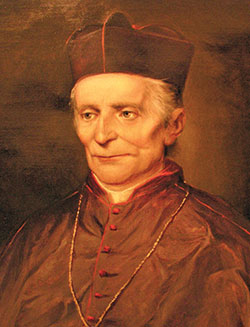 Catholic identity and mission have a rich history in Indiana. Pope Clement X established the Diocese of Quebec, in 1674, which included the territory known today as Indiana. Sacramental records began being kept at St. Francis Xavier Church, in Vincennes, in 1749. In 1770, Father Pierre Gibault became the pastor at Vincennes.
Catholic identity and mission have a rich history in Indiana. Pope Clement X established the Diocese of Quebec, in 1674, which included the territory known today as Indiana. Sacramental records began being kept at St. Francis Xavier Church, in Vincennes, in 1749. In 1770, Father Pierre Gibault became the pastor at Vincennes.
The Northwest Ordinance of 1787 guaranteed religious freedom throughout the territory. In 1789, Vincennes came under the ecclesiastical jurisdiction of the Diocese of Baltimore. The Indiana Territory was established in 1800, with Vincennes being designated as its capital. The Diocese of Bardstown, in Kentucky, was established on 8 April 1808, which included all of the Indiana Territory. Flaget Elementary School, the current Catholic grade school in Vincennes, is named after the first Bishop of Bardstown, Joseph Benedict Flaget. Bishop Flaget was the first known Catholic bishop in the Indiana Territory, in 1814, administering the sacrament of confirmation in Vincennes. In 1816, Indiana became the nineteenth state.
The Diocese of Vincennes—now the Archdiocese of Indianapolis—was established by Pope Gregory XVI on May 6, 1834. The territory then comprised the entire state of Indiana and the eastern third of Illinois. The latter was separated from the Diocese of Vincennes upon the establishment of the Diocese of Chicago, November 28, 1843.
Fr. Simon Bruté, trained as a physician in France, was named the first bishop of Vincennes. Bishop Bruté served for five years until his death In 1839. There would be four more bishops appointed and several parishes established until the diocesan see was transferred to Indianapolis in 1898. The first four bishops are buried in the crypt of St. Francis Xavier Basilica, in Vincennes.
 By decree of Pope Pius IX, January 8, 1857, the northern half of the state became the Diocese of Fort Wayne, the boundaries being that part of the state north of the south boundaries of Fountain, Montgomery, Boone, Hamilton, Madison, Delaware, Randolph, and Warren counties. The remaining southern half of the state made up the Diocese of Vincennes, embracing 50 counties. It covered an area of 18,479 square miles extending from the north boundaries of Marion and contiguous counties to the Ohio River and from Illinois on the west to Ohio on the east.
By decree of Pope Pius IX, January 8, 1857, the northern half of the state became the Diocese of Fort Wayne, the boundaries being that part of the state north of the south boundaries of Fountain, Montgomery, Boone, Hamilton, Madison, Delaware, Randolph, and Warren counties. The remaining southern half of the state made up the Diocese of Vincennes, embracing 50 counties. It covered an area of 18,479 square miles extending from the north boundaries of Marion and contiguous counties to the Ohio River and from Illinois on the west to Ohio on the east.
The second bishop of Vincennes was permitted by apostolic brief to establish his residence at Vincennes, Madison, Lafayette, or Indianapolis; Vincennes was, however, to remain the see city. This permission, with the subtraction of Lafayette, was renewed to the fourth bishop.
Upon his appointment in 1878, Bishop Francis Chatard, the fifth bishop of Vincennes, was directed to fix his residence at Indianapolis. Although the site of the cathedral and the title of the see were continued at Vincennes, Bishop Chatard used St. John the Evangelist Parish in Indianapolis as an unofficial cathedral until the Cathedral of SS. Peter and Paul was completed in 1907. St. John the Evangelist Parish, established in 1837, was the first parish in Indianapolis and Marion County.
By apostolic brief dated March 28, 1898, the title of the diocese was changed to that of “Diocese of Indianapolis,” with the episcopal see in the city of Indianapolis. Although the bishop’s official residence was changed, the patron of the diocese remained St. Francis Xavier, the title of the Old Cathedral at Vincennes. In 2006, following the canonization of Mother Theodore Guérin, the first canonized saint from the archdiocese, the Holy See proclaimed her as patroness of the archdiocese along with Francis Xavier.
 An apostolic decree of His Holiness Pope Pius XII, creating the Archdiocese of Indianapolis, was issued October 21, 1944. On December 19, 1944, by executorial decree of the papal delegate, the Most Reverend Amleto Giovanni Cicognani, apostolic delegate to the United States, the papal decree of Pope Pius XII was solemnly proclaimed in SS. Peter and Paul Cathedral, elevating Indianapolis to the status of an archdiocese, the state of Indiana becoming the metropolitan area. The dioceses of Evansville and Lafayette-in-Indiana were created by the same decree and, along with the Diocese of Fort Wayne, made suffragan sees of Indianapolis. Upon establishment of the Diocese of Gary on February 25, 1957, it too became a suffragan see.
An apostolic decree of His Holiness Pope Pius XII, creating the Archdiocese of Indianapolis, was issued October 21, 1944. On December 19, 1944, by executorial decree of the papal delegate, the Most Reverend Amleto Giovanni Cicognani, apostolic delegate to the United States, the papal decree of Pope Pius XII was solemnly proclaimed in SS. Peter and Paul Cathedral, elevating Indianapolis to the status of an archdiocese, the state of Indiana becoming the metropolitan area. The dioceses of Evansville and Lafayette-in-Indiana were created by the same decree and, along with the Diocese of Fort Wayne, made suffragan sees of Indianapolis. Upon establishment of the Diocese of Gary on February 25, 1957, it too became a suffragan see.
The current size of the Archdiocese of Indianapolis is 13,757.7 square miles, according to 1990 measurements from the Indiana State Library Reference Division, and comprises the counties of Bartholomew, Brown, Clark, Clay, Crawford, Dearborn, Decatur, Fayette, Floyd, Franklin, Hancock, Harrison, Hendricks, Henry, Jackson, Jefferson, Jennings, Johnson, Lawrence, Marion, Monroe, Morgan, Ohio, Orange, Owen, Parke, Perry, Putnam, Ripley, Rush, Scott, Shelby, Switzerland, Union, Vermillion, Vigo, Washington, and Wayne and the township of Harrison in Spencer County, in the southern part of Indiana.
 Today the Roman Catholic Archdiocese of Indianapolis comprises 126 parishes, 68 schools, six Catholic Charities agencies and many offices of ministry across central and southern Indiana. There is a strong presence of consecrated women and men, including Benedictines, Franciscans, Sisters of Providence of Saint Mary-of-the-Woods, Carmelites and Jesuits. Two Catholic colleges, Marian University and St. Mary-of-the-Woods College, serve students from Indiana and many other regions of the United States and the international community. Bishop Simon Bruté College Seminary in Indianapolis was opened in 2004 to prepare college seminarians for major seminary. Saint Meinrad Seminary and School of Theology, founded in 1861 in St. Meinrad, Indiana, provides formation for priests, deacons and lay ministers.
Today the Roman Catholic Archdiocese of Indianapolis comprises 126 parishes, 68 schools, six Catholic Charities agencies and many offices of ministry across central and southern Indiana. There is a strong presence of consecrated women and men, including Benedictines, Franciscans, Sisters of Providence of Saint Mary-of-the-Woods, Carmelites and Jesuits. Two Catholic colleges, Marian University and St. Mary-of-the-Woods College, serve students from Indiana and many other regions of the United States and the international community. Bishop Simon Bruté College Seminary in Indianapolis was opened in 2004 to prepare college seminarians for major seminary. Saint Meinrad Seminary and School of Theology, founded in 1861 in St. Meinrad, Indiana, provides formation for priests, deacons and lay ministers.
Archbishop Charles C. Thompson was appointed the seventh archbishop of Indianapolis on June 13, 2017, by Pope Francis. He was installed in SS. Peter and Paul Cathedral on July 28, 2017.
Roman Catholic Archdiocese of Indianapolis Strategic Goals, Objectives and Strategies
January 2020
We, the Roman Catholic Archdiocese of Indianapolis, joyfully proclaim the Gospel of Jesus Christ to all people by living His mission of mercy, hope and salvation.
Prayer and Worship
 GOAL 1: Foster a personal encounter with Jesus Christ through a rich and vibrant liturgical, sacramental and devotional, and personal prayer life.
GOAL 1: Foster a personal encounter with Jesus Christ through a rich and vibrant liturgical, sacramental and devotional, and personal prayer life.
Objective 1.1 Cultivate a sense of belonging for all God’s people through liturgical experiences that honor our growing cultural and ethnic diversity.
Objective 1.2 Offer resources to parishes to encourage the full, active, and conscious participation of all the faithful in the liturgical life of the Church.
Objective 1.3 Enrich and complement the faithful’s understanding of the Gospel, scripture and liturgy through music and song that honors and celebrates our cultural and ethnic diversity.
Objective 1.4 Foster the spiritual life of God’s people through “popular piety” devotions.
Action 1.4.1 Identify and design resources as necessary to deepen the faithful’s understanding and use of Catholic prayers and devotionals.
Objective 1.5 Promote sacramental preparation as a tool of new evangelization, as an encounter for candidates, families and sponsors with the risen Lord.
Stewardship
 GOAL 2: Cultivate a culture of stewardship responding to our Baptismal call through the giving of one’s time, talent and treasure in the service of God and others.
GOAL 2: Cultivate a culture of stewardship responding to our Baptismal call through the giving of one’s time, talent and treasure in the service of God and others.
Objective 2.1 Foster an increased sense of discipleship among the people by helping them identify the gifts that God has given them, and how those gifts can be put into service to build up His kingdom through the Church.
Action 2.1.1 Issue a call to action for a plan to evangelize/catechize the faithful.
Objective 2.2 Design and implement an archdiocesan-wide system that connects/coordinates the faithful’s gifts/talents with the needs of the archdiocese, wider-community, and the parish and invites and actively engages the faithful into service of others.
Action 2.2.1 Assess communication structures within the archdiocese and respond with the development of effective models that utilize a variety of methods and address needs.
Objective 2.3 Conduct a comprehensive assessment or audit of all capital assets and facilities within the Archdiocese regarding short/long term maintenance and usability (building on previous audits/assessments) and develop standardized methods and reports to assess resources and the pastoral needs throughout the Archdiocese.
Objective 2.4 Continue to utilize the tools and resources gained from Empowering Pastoral Leaders as a means to build up the leadership capacity, skills and talents of all.
Family and Community
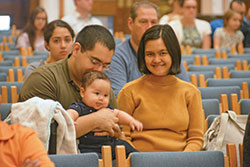 GOAL 3: Support and engage families and communities in the Archdiocese.
GOAL 3: Support and engage families and communities in the Archdiocese.
Objective 3.1 Recognize the family as the core of our evangelization efforts and pastoral ministry.
Action 3.1.1 Nurture Catholic marriages and Catholic family life through experiences that deepen encounters with Jesus Christ.
Action 3.1.2 Develop ways to engage and support the needs of families.
Action 3.1.3 Encourage the use of a spiritual gifts assessment or inventory in our parishes, agencies, schools, and organizations
Objective 3.2 Offer resources and experiences to Catholic households in fostering and discerning vocations.
Objective 3.3 Cultivate communities that are centered around invitation and evangelization for people in all phases of life.
Objective 3.4 Affirm and promote the role of parents as the primary teachers and formators of their children’s faith.
Objective 3.5 Design outreach programs and resources to actively invite and welcome inactive Catholics, to extend hospitality to first time visitors, and to warmly receive those seeking a church home.
Evangelization and Catechesis
 GOAL 4: Live with an attitude of missionary discipleship of all people, reaching out to the peripheries of our diocese, parishes, and communities.
GOAL 4: Live with an attitude of missionary discipleship of all people, reaching out to the peripheries of our diocese, parishes, and communities.
Objective 4.1 Foster a sense of belonging in our archdiocese through an attitude of encounter.
Objective 4.2 Restore the meaning of joy by Proclaiming and Evangelizing the Good News.
Objective 4.3 Create a culture of intentional discipleship.
Objective 4.4 Make youth and young adults participation in all levels of pastoral ministry a priority.
Objective 4.5 Promote effective instruments of evangelization through solid catechesis.
Action 4.5.1 Develop an understanding that evangelization is not limited to Sunday liturgies.
Action 4.5.2 Accompany and support small ecclesial groups within the parish.
Action 4.5.3 Foster the integration of ethnic communities and people with disabilities into the parish and diocesan structures.
Objective 4.6 Identify and develop catechetical training models with an emphasis on the use of technology and social media.
Objective 4.7 Promote comprehensive life-long formation in the faith by facilitating emotional, spiritual and intellectual conversion.
Clergy Life and Ministry
 GOAL 5: Ensure the spiritual and physical well-being of the clergy (priests and deacons) by spiritual vitality, organizational efficacy, and sound stewardship principles and practices.
GOAL 5: Ensure the spiritual and physical well-being of the clergy (priests and deacons) by spiritual vitality, organizational efficacy, and sound stewardship principles and practices.
Objective 5.1 Ensure the spiritual and physical well-being of the clergy.
Action 5.1.1 Identify opportunities for clergy and lay sabbaticals and professional development.
Action 5.1.2 Foster a culture of priestly identity and support through local and archdiocesan-wide opportunities and gatherings that promote and affirm the priestly vocation.
Objective 5.2 Create a framework identifying the necessary components of a thriving parish as we prepare for the existing and future changes of clergy, religious and lay leadership in the Archdiocese.
Action 5.2.1 Create new and innovative strategies, structures, and systems that respond to the needs in changing parish life and at the same time support the well-being of our parish leadership.
Action 5.2.2 Develop standardized methods and reports to assess resources (human, material and financial) and the pastoral needs throughout the Archdiocese.
Action 5.2.3 Review existing strategic and pastoral plans to coordinate needs and human resources.
Action 5.2.4 Conduct and analyze a comprehensive assessment of Mass times, clergy availability, staffing and parishioners in every deanery.
Action 5.2.5 Examine the current deanery structure in light of emerging trends and assumptions regarding future clergy.
Action 5.2.6 Develop a comprehensive communications plan to educate the local Church and promote awareness and understanding of future changes.
Action 5.2.7 Identify, call forth and clarify lay ecclesial leadership to serve the needs of changing parish and diocesan structures. (For example: what do we need to do to train PLC’s, pastoral associates, youth ministers, etc.?)
Map of the Archdiocese of Indianapolis


 In his 2013 Apostolic Exhortation Evangelii gaudium (“The Joy of the Gospel”), Pope Francis invited the entire Church “to embark on a new chapter of evangelism.” He also challenged us to understand ourselves as a “community of missionary disciples” who are “permanently in a state of mission” (EG #s 1–3). This state of mission defines our Church’s ministry in both good times and hard times. As our Holy Father observes:
In his 2013 Apostolic Exhortation Evangelii gaudium (“The Joy of the Gospel”), Pope Francis invited the entire Church “to embark on a new chapter of evangelism.” He also challenged us to understand ourselves as a “community of missionary disciples” who are “permanently in a state of mission” (EG #s 1–3). This state of mission defines our Church’s ministry in both good times and hard times. As our Holy Father observes: Even in challenging times such as these, God takes the initiative, and he gives us everything we need to carry out his work. Our responsibility as disciples and missionaries is to gather around the Lord to pray, to listen to God’s Word and to encounter him in the sacraments and the liturgy. Then, we must accept his commission to “go out to the whole world” in our proclamation of the Gospel and in service to others.
Even in challenging times such as these, God takes the initiative, and he gives us everything we need to carry out his work. Our responsibility as disciples and missionaries is to gather around the Lord to pray, to listen to God’s Word and to encounter him in the sacraments and the liturgy. Then, we must accept his commission to “go out to the whole world” in our proclamation of the Gospel and in service to others. More than 20 years ago, Pope St. John Paul II outlined the task that the Church faced as we prepared to enter into a new millennium:
More than 20 years ago, Pope St. John Paul II outlined the task that the Church faced as we prepared to enter into a new millennium: Pope Francis echoes this teaching when he speaks about the importance of “pastoral conversion” which is much more than restructuring our parishes, schools and diocesan institutions. The “exciting work of pastoral revitalization” that St. John Paul says awaits us all is what Pope Francis means when he talks about “pastoral ministry in a missionary key.”
Pope Francis echoes this teaching when he speaks about the importance of “pastoral conversion” which is much more than restructuring our parishes, schools and diocesan institutions. The “exciting work of pastoral revitalization” that St. John Paul says awaits us all is what Pope Francis means when he talks about “pastoral ministry in a missionary key.”  On 19 February 2020, before the spread of the COVID-19 pandemic compelled us to suspend temporarily all public gatherings including Mass and the sacraments, I accepted as proposed by the planning committee a new archdiocesan pastoral plan that will guide the way we carry out the Church’s mission in central and southern Indiana for the next three years. This plan is the result of several years of surveys, assessments and research beginning during the interim between the appointment of Cardinal Joseph W. Tobin as archbishop of Newark, N.J., and my installation as archbishop of Indianapolis on 28 July 2017.
On 19 February 2020, before the spread of the COVID-19 pandemic compelled us to suspend temporarily all public gatherings including Mass and the sacraments, I accepted as proposed by the planning committee a new archdiocesan pastoral plan that will guide the way we carry out the Church’s mission in central and southern Indiana for the next three years. This plan is the result of several years of surveys, assessments and research beginning during the interim between the appointment of Cardinal Joseph W. Tobin as archbishop of Newark, N.J., and my installation as archbishop of Indianapolis on 28 July 2017.  I also want to acknowledge gratefully the other 21 members of the Archdiocesan Pastoral Planning Committee:
I also want to acknowledge gratefully the other 21 members of the Archdiocesan Pastoral Planning Committee: Especially as we return to full engagement in the mission and ministries of our archdiocese, there are many advantages to having a pastoral plan that can serve as a practical guide for all our ministries. Our pastoral plan provides a means for shared vision and coordinated, intentional efforts. The plan also identifies particular goals and objectives that need to be addressed in this moment of our archdiocese’s history. Finally, the plan makes it possible for us to work together as a family of faith rather than trying to address each issue as isolated individuals.
Especially as we return to full engagement in the mission and ministries of our archdiocese, there are many advantages to having a pastoral plan that can serve as a practical guide for all our ministries. Our pastoral plan provides a means for shared vision and coordinated, intentional efforts. The plan also identifies particular goals and objectives that need to be addressed in this moment of our archdiocese’s history. Finally, the plan makes it possible for us to work together as a family of faith rather than trying to address each issue as isolated individuals. The Archdiocesan Pastoral Planning Committee was responsible for prayerfully considering the results of the assessments, surveys and other research conducted in preparation for pastoral planning. This was truly a process of prayerful discernment using Sacred Scripture, the teaching and practice of the Church during the past two millennia, and Pope Francis’s recent teaching, especially The Joy of the Gospel, as guides. The result was a series of Goals and Objectives in the following areas:
The Archdiocesan Pastoral Planning Committee was responsible for prayerfully considering the results of the assessments, surveys and other research conducted in preparation for pastoral planning. This was truly a process of prayerful discernment using Sacred Scripture, the teaching and practice of the Church during the past two millennia, and Pope Francis’s recent teaching, especially The Joy of the Gospel, as guides. The result was a series of Goals and Objectives in the following areas: The first goal of our Archdiocesan Pastoral Plan is: Foster a personal encounter with Jesus Christ through a rich and vibrant liturgical, sacramental and devotional, and personal prayer life. Prayer and Worship are at the heart of our identity as Catholic Christians. They prepare us to encounter Jesus in Word, Sacrament and Service, and they nourish and sustain us as we carry out our mission to joyfully proclaim the Gospel and live Christ’s mission of mercy, hope and salvation. The encounter with Jesus Christ that our liturgy and the sacraments foster is never a purely private affair. Mass and the sacraments, especially, are meant to be communal celebrations which both unite us in worship and strengthen us as individuals and communities in love of God and love of neighbor.
The first goal of our Archdiocesan Pastoral Plan is: Foster a personal encounter with Jesus Christ through a rich and vibrant liturgical, sacramental and devotional, and personal prayer life. Prayer and Worship are at the heart of our identity as Catholic Christians. They prepare us to encounter Jesus in Word, Sacrament and Service, and they nourish and sustain us as we carry out our mission to joyfully proclaim the Gospel and live Christ’s mission of mercy, hope and salvation. The encounter with Jesus Christ that our liturgy and the sacraments foster is never a purely private affair. Mass and the sacraments, especially, are meant to be communal celebrations which both unite us in worship and strengthen us as individuals and communities in love of God and love of neighbor.  Our third goal is: Support and engage families and communities in the archdiocese. Assessments, surveys and research conducted in preparation for pastoral planning show clearly that the family, which is the most fundamental unit of civil society, and which we recognize as “the domestic church,” needs encouragement, support and direction in its efforts to flourish and grow in our contemporary culture. Recent popes have emphasized that the family is the primary place where catechesis, evangelization and social awareness are nurtured, developed and put into action to carry out our Church’s mission in the world.
Our third goal is: Support and engage families and communities in the archdiocese. Assessments, surveys and research conducted in preparation for pastoral planning show clearly that the family, which is the most fundamental unit of civil society, and which we recognize as “the domestic church,” needs encouragement, support and direction in its efforts to flourish and grow in our contemporary culture. Recent popes have emphasized that the family is the primary place where catechesis, evangelization and social awareness are nurtured, developed and put into action to carry out our Church’s mission in the world. Our final goal is: Ensure the spiritual and physical well-being of the clergy by spiritual vitality, organizational efficiency, and sound stewardship principles and practices. All of the goals in our pastoral plan are vitally important, but this goal is especially significant today as we emerge from decades of crisis and humiliation resulting from the heinous crimes and grave sins of some bishops, priests and church leaders. As a Church, we love our clergy and we want them to succeed in the vocation given them by Christ to serve as pastors and ministers of all God’s people. We know that the prayerful help and support of the entire archdiocesan family is needed to nurture, affirm and guide our deacons, priests and bishops as we strive to grow spiritually and mature as effective pastoral ministers.
Our final goal is: Ensure the spiritual and physical well-being of the clergy by spiritual vitality, organizational efficiency, and sound stewardship principles and practices. All of the goals in our pastoral plan are vitally important, but this goal is especially significant today as we emerge from decades of crisis and humiliation resulting from the heinous crimes and grave sins of some bishops, priests and church leaders. As a Church, we love our clergy and we want them to succeed in the vocation given them by Christ to serve as pastors and ministers of all God’s people. We know that the prayerful help and support of the entire archdiocesan family is needed to nurture, affirm and guide our deacons, priests and bishops as we strive to grow spiritually and mature as effective pastoral ministers. Catholic identity and mission have a rich history in Indiana. Pope Clement X established the Diocese of Quebec, in 1674, which included the territory known today as Indiana. Sacramental records began being kept at St. Francis Xavier Church, in Vincennes, in 1749. In 1770, Father Pierre Gibault became the pastor at Vincennes.
Catholic identity and mission have a rich history in Indiana. Pope Clement X established the Diocese of Quebec, in 1674, which included the territory known today as Indiana. Sacramental records began being kept at St. Francis Xavier Church, in Vincennes, in 1749. In 1770, Father Pierre Gibault became the pastor at Vincennes.  By decree of Pope Pius IX, January 8, 1857, the northern half of the state became the Diocese of Fort Wayne, the boundaries being that part of the state north of the south boundaries of Fountain, Montgomery, Boone, Hamilton, Madison, Delaware, Randolph, and Warren counties. The remaining southern half of the state made up the Diocese of Vincennes, embracing 50 counties. It covered an area of 18,479 square miles extending from the north boundaries of Marion and contiguous counties to the Ohio River and from Illinois on the west to Ohio on the east.
By decree of Pope Pius IX, January 8, 1857, the northern half of the state became the Diocese of Fort Wayne, the boundaries being that part of the state north of the south boundaries of Fountain, Montgomery, Boone, Hamilton, Madison, Delaware, Randolph, and Warren counties. The remaining southern half of the state made up the Diocese of Vincennes, embracing 50 counties. It covered an area of 18,479 square miles extending from the north boundaries of Marion and contiguous counties to the Ohio River and from Illinois on the west to Ohio on the east. An apostolic decree of His Holiness Pope Pius XII, creating the Archdiocese of Indianapolis, was issued October 21, 1944. On December 19, 1944, by executorial decree of the papal delegate, the Most Reverend Amleto Giovanni Cicognani, apostolic delegate to the United States, the papal decree of Pope Pius XII was solemnly proclaimed in SS. Peter and Paul Cathedral, elevating Indianapolis to the status of an archdiocese, the state of Indiana becoming the metropolitan area. The dioceses of Evansville and Lafayette-in-Indiana were created by the same decree and, along with the Diocese of Fort Wayne, made suffragan sees of Indianapolis. Upon establishment of the Diocese of Gary on February 25, 1957, it too became a suffragan see.
An apostolic decree of His Holiness Pope Pius XII, creating the Archdiocese of Indianapolis, was issued October 21, 1944. On December 19, 1944, by executorial decree of the papal delegate, the Most Reverend Amleto Giovanni Cicognani, apostolic delegate to the United States, the papal decree of Pope Pius XII was solemnly proclaimed in SS. Peter and Paul Cathedral, elevating Indianapolis to the status of an archdiocese, the state of Indiana becoming the metropolitan area. The dioceses of Evansville and Lafayette-in-Indiana were created by the same decree and, along with the Diocese of Fort Wayne, made suffragan sees of Indianapolis. Upon establishment of the Diocese of Gary on February 25, 1957, it too became a suffragan see. Today the Roman Catholic Archdiocese of Indianapolis comprises 126 parishes, 68 schools, six Catholic Charities agencies and many offices of ministry across central and southern Indiana. There is a strong presence of consecrated women and men, including Benedictines, Franciscans, Sisters of Providence of Saint Mary-of-the-Woods, Carmelites and Jesuits. Two Catholic colleges, Marian University and St. Mary-of-the-Woods College, serve students from Indiana and many other regions of the United States and the international community. Bishop Simon Bruté College Seminary in Indianapolis was opened in 2004 to prepare college seminarians for major seminary. Saint Meinrad Seminary and School of Theology, founded in 1861 in St. Meinrad, Indiana, provides formation for priests, deacons and lay ministers.
Today the Roman Catholic Archdiocese of Indianapolis comprises 126 parishes, 68 schools, six Catholic Charities agencies and many offices of ministry across central and southern Indiana. There is a strong presence of consecrated women and men, including Benedictines, Franciscans, Sisters of Providence of Saint Mary-of-the-Woods, Carmelites and Jesuits. Two Catholic colleges, Marian University and St. Mary-of-the-Woods College, serve students from Indiana and many other regions of the United States and the international community. Bishop Simon Bruté College Seminary in Indianapolis was opened in 2004 to prepare college seminarians for major seminary. Saint Meinrad Seminary and School of Theology, founded in 1861 in St. Meinrad, Indiana, provides formation for priests, deacons and lay ministers. GOAL 1: Foster a personal encounter with Jesus Christ through a rich and vibrant liturgical, sacramental and devotional, and personal prayer life.
GOAL 1: Foster a personal encounter with Jesus Christ through a rich and vibrant liturgical, sacramental and devotional, and personal prayer life. GOAL 2: Cultivate a culture of stewardship responding to our Baptismal call through the giving of one’s time, talent and treasure in the service of God and others.
GOAL 2: Cultivate a culture of stewardship responding to our Baptismal call through the giving of one’s time, talent and treasure in the service of God and others. GOAL 3: Support and engage families and communities in the Archdiocese.
GOAL 3: Support and engage families and communities in the Archdiocese. GOAL 4: Live with an attitude of missionary discipleship of all people, reaching out to the peripheries of our diocese, parishes, and communities.
GOAL 4: Live with an attitude of missionary discipleship of all people, reaching out to the peripheries of our diocese, parishes, and communities. GOAL 5: Ensure the spiritual and physical well-being of the clergy (priests and deacons) by spiritual vitality, organizational efficacy, and sound stewardship principles and practices.
GOAL 5: Ensure the spiritual and physical well-being of the clergy (priests and deacons) by spiritual vitality, organizational efficacy, and sound stewardship principles and practices.